zWAN Client – CLIENT SOFTWARE TO FACILITATE WORK-FROM-HOME (WFH)
Work From Home

Many companies have traditionally adopted Virtual Private Network (VPN), which offers the easiest and quickest path to address the short-term need of supporting remote workers. When Covid-19 hit in the spring of 2020, VPN offered the quickest path to support a work-from-home model, allowed remote workers to connect to their desktops at work and connect to the corporate network.
While we are now in the post-Covid era, all workers have not returned to the office, and remote work has become a permanent fixture and is here to stay. According to Forbes, Bryan Robinson, Ph.D., “25% of all professional jobs in North America will be remote by the end of 2022.” Remote work leapt from sub 4% of all high paying jobs to more than 15% in 2021. As for 2023, analysts are projecting another major increase in the number of permanent remote workers. While remote work is popular, it has raised several issues.
Problems with Work From Home
The work force is constantly evolving and it is apparent that remote work is a permanent fixture. Remote opportunities leapt from under 4% of all high paying jobs to more than 15% in the past year. In the near future 25% of all professional jobs in North America will be remote. Over the next year, we will see a major increase in the number of permanent remote workers.
Employees and Employers share a different viewpoint of Working from Home (WFH). Employees enjoy working remotely and feel they are very productive working outside of an office environment. However, employees are concerned with security, employee productivity, OpEx costs and the overall employee experience of WFH.
The Employee Viewpoint: Owl Labs surveyed 2,050 fulltime remote workers and found the following:
• 90% of remote workers surveyed said they were as or more productive working remotely, compared to when they were in the office.
• 74% agreed that working from home is better for their mental health.
• 84% of remote workers surveyed said they are much happier working remotely and would even be willing to take a pay cut to remain working remotely.
The Employer Viewpoint: Employers like Apple and Google have stated that they want their employees back in the office mainly due to security concerns and poor employee productivity. Elon Musk recently stated, “Remote work is no longer acceptable… [remote workers] should pretend to work somewhere else”.
The main concerns from the employer perspective are as follows:
- Security Issues – Hacker Targets
Hackers are targeting Home Networks and Devices. A never-before-seen remote access trojan dubbed ZuoRAT has been singling out small office/home office (SOHO) routers as part of a sophisticated campaign targeting North American and European networks. Warnings about nation-actors’ intrusion campaigns aim to exploit publicly identified security flaws in network devices such as Small Office/Home Office (SOHO) routers and Network Attached Storage (NAS) devices with the goal of gaining deeper access to victim networks.
- Operational Expenditure (OpEx) Issues
WFH inherently brings about more OpEx issues in the form of complexities in network requirements and an overall increase in IT OpEx. Network requirements increase from needing to on-board additional devices for employees to work from remotely and needing to manage all those devices, an increased investment in a more reliant VPN infrastructure for all the remote connections being established, and an increase in support for remote users. Overall IT OpEx increases include increased support and maintenance costs, having to buy more equipment for remote users, and increased ISP related expenses.
- Employee Productivity Issues
Most employers feel remote employees spend too much time on home or personal items and less time on work related items. A lot of employers share the viewpoint of “out of sight, out of mind”. Without having visual observation on its employees, employers are always questioning the productivity of their employees. However, there are studies and reports that paint a very different picture. A study by Stanford of 16,000 workers over 9 months found that working from home increase productivity by 13%. This increase in performance was due to more calls per minute attributed to a quieter more convenient working environment and working more minutes per shift because of fewer breaks and sick days. In this same study workers also reported improved work satisfaction, and attrition rates were cut by 50%.
- Employee Experience Issues
Employees working remotely face many issues that a conventional in-office user doesn’t normally experience. One of the biggest problems they face is the lack of an on-site IT support staff. A majority of a typical organization’s workforce is typically non-technical, meaning that if technical problems arise, they will have a hard time trying to debug the issue themselves without the help of IT Support. Other issues that may arise deal with the type of internet service users have. Some users may have slower speeds from their ISPs than others or they may be in more remote/rural areas. There may not be adequate Wi-Fi coverage in their home, creating dead spots. All of these issues can have a negative impact on day-to-day activities such as video conference call quality and responsiveness to remote corporate resources.
Benefits of Work From Home
Stories and coins have two sides, so we Employers must weigh the benefits of WFH as well. Working remote provides benefits to Employers and Employees alike. Listed below are the main benefits supporting a remote workforce.
Listed below are the main benefits supporting a remote workforce.
The Employee Benefits:
- Convenient Work/Home Balance
Employees can enjoy a greater freedom & flexibility working remotely or from home. Home chores can be completed during lunch break and tasks such as home repairs or pest exterminators can be welcomed into the home while the employee still works.
- Location
Remote working has allowed a large number of employees to return to small or rural towns where they were born and raised. It has also allowed employees to leave expensive cites and move into the suburbs where the costs of homes and land and more affordable.
- Less Traffic & Pollution Reduction
More employees working from home reducing traffic in major cities. Less cars on the roads and highways means less pollution too. Not sitting in traffic is a major stress relief for employees as well
- Cost of Savings
Working from home allows for savings on fuel costs, vehicle mileage and maintenance costs as well as food costs. There are a lot of savings that a work from home employee can enjoy by working from within their home
Employers can greatly benefit from a WFH environment for its employees. Listed below are a few of the main benefits to employers who support a WFH model.
The Employer Benefits:
- Cost Effective & Instant ROI
There are significant costs savings associated with WFH for both employees and employers. More employees remotely mean less employees in an office or leased building. Companies can downsize on leases, real estate, utilities, office supplies, equipment and insurance.
- Unified Security with ZTNA
Zero Trust Network Access (ZTNA) allows employers to extend security measures across all layers of the digital estate that explicitly and continuously verify every transaction, asserts least privilege, and relies on intelligence, advanced detection, and real-time response to threats. ZTNA is based on the idea of never trust, always verify, meaning that this approach protects companies and users by managing and granting access based on the continual verification of identities, devices and services.
- End-To-End Employee Monitoring
Employers can install software in the remote workers devices and computers to track their productivity and generate real time reports on apps used, data accessed, emails sent and more. Employers can drill down into an employee’s actions to ensure the employee is productive while also auditing the work output.
- Expanded Talent Pool
Companies can greatly benefit by being able to attract employees from a wider geographic area. Instead of drawing resumes and applicants from local candidates, employers can now post job openings and attract more and better talent.

Bridge the Gap – The Complete WFH Solution
AmZetta’s zWAN Client utilizes the existing home network underlay connectivity such as broadband, internet, Wi-Fi, LTE or 5G and routes the data within the network using highly secure overlay tunnels that are encrypted. The zWAN Client monitors the performance of the network and WAN connections and manages all network traffic to optimize connectivity of users to applications consistent with QoS and SLA objectives.
- Seamless Integration – Fits Seamlessly into Existing Home Networks
AmZetta’s zWAN Client makes it quick and easy for employees to setup at home. Employees can either deploy a software solution on their corporate devices that requires a simple installation process and then they are ready to connect securely. A hardware solution can also be deployed that allows employees to add a device to their existing home network and then connect their corporate device to it, either directly or through Wi-Fi with no disruption to the overall home network.
- No Changes to the Home Network Setup
Whether an employee opts to leverage the software or hardware solution, neither solution requires any change to the overall home network. Employees don’t have to change any settings on their home network devices in order to integrate the zWAN Client. Spouses and children can continue to connect to the home network without having to change which Wi-Fi networks they connect.
- SaaS/Internet App Breakout
The zWAN Client can be configured to classify packets and steer them directly to the Internet or specific corporate destinations, be it a data center or branch office or even cloud resources. The advantages of this feature include reducing latency by reducing the number of hops required to reach a specific destination. This also reduces the amount of data traversing the corporate backbone, as packets deemed to be going to trusted SaaS applications can go directly to those destination without first having to be scrubbed by corporate firewalls.
- Load Balance & Failover
Load Balancing divides traffic along multiple WAN interfaces to reduce Network congestion. AmZetta’s zWAN Client supports multiple WAN interfaces including broadband, internet, Wi-Fi, LTE or 5G. One WAN interface will be the primary data path while the secondary WAN interface will be the secondary data path. The zWAN Client will automatically failover from the primary WAN interface to the secondary WAN interface if it detects any failure or downed scenario with the primary WAN interface.
- Simple Installation Process
A simple single step installation process that is designed for non-technical employees to perform. The installation process is done via a simple and intuitive wizard.
The AmZetta zWAN Work From Home (WFH) Solution
AmZetta’s zWAN provides organizations with a comprehensive Work from Home (WFH) solution and has the following software components:
The zWAN Client can be installed on any corporate laptop or desktop that an employee uses at home without the need for any additional hardware in their home network. The Provider also runs on Commercial Off-the-shelf (COTS) x86 hardware or can be hosted in a virtual machine (VM). The Provider has a simple, intuitive interface that makes managing, configuring, and monitoring the WFH environment a breeze. AmZetta’s zero-touch provisioning allows organizations to quickly integrate new components to the overall WFH architecture with ease by allowing the configuration and settings to be auto-downloaded and applied by the main orchestrator, no matter where the component is being implemented.

Benefits


Enhanced Security
Extend Corporate Security to protect Data, Apps, Devices and User Access at Remote Locations

Network Separation
Separate Corporate Network Traffic from Personal Home Network Traffic

Extensive Report Generation
Extensive logs are available, which are parsed to provide reports on employee activities
Product Links

Ready to evaluate the zWAN Client?
Just click on this link and fill out the short form. An AmZetta Solutions Engineer will email you a download link to the zClient and the credentials to log into a zWAN demo instance. You will be able to check out the remote user endpoint perspective as well as the backend provider and management perspective.